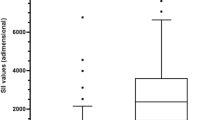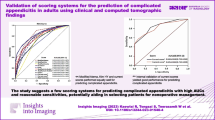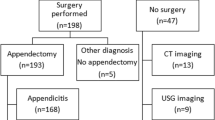Summary.
A diagnostic scoring system, recently published by Ohmann et al. in this journal, was validated by analyzing the clinicopathological data of a consecutive series of 2,359 patients, admitted for suspicion of acute appendicitis. The results of the scoring system were compared to the results of clinical evaluation by junior (provisional) and senior surgeons (final clinical diagnosis). To assess the diagnostic ability of the score, the accuracy and positive predictive value were defined as the major diagnostic performance parameters; the rate of theoretical negative laparotomies and that of diagnostic errors served as the major procedural performance parameters. Of 2,359 patients admitted for suspected acute appendicitis, 662 were proven to have acute appendicitis by histology, for a prevalence of 28 %. The overall sensitivity, specificity, positive predictive value, negative predictive value, and accuracy of the provisional clinical diagnosis were 0.50, 0.94, 0.77, 0.83, and 0.82; 0.93, for the score 0.63, 0.93, 0.77, 0.86 and 0.84, and for the final clinical diagnosis 0.90, 0.94, 0.85, 0.96, and 0.93, respectively. Of the main diagnostic performance parameter, the accuracy of the score was signifianctly better than that of provisional clinical diagnosis (P < 0.05, χ 2 test). The score yielded a rate of negative appendecomies and laparotomies of 14.3 and 12.3 %. With respect to the rate of overlooked cases of acute apendicitis, the score demonstrated a superior performance, with only 6 cases missed (0.9 %). However, the number of patients with acute appendicitis, including those with perforated disease, who were not identified by the score, was almost four times that of the final clinical diagnosis (245 vs 63). With regard to the main procedural performance parameter, the score resulted in a significantly smaller number of diagnostic errors than the provisional clinical investigator (P < 0.05, χ 2 test). The results of this study indicate that the diagnostic scoring system might be helpful when experienced investigators or additional diagnostic modalities such as ultrasonography are not available. It may therefore be of value in the preclinical evaluation of patients with suspected acute appendicitis and may be instrumental as a quality control tool and in clinical guidelines.
Zusammenfassung.
Ein von Ohmann et al. in dieser Zeitschrift vorgestellter diagnostischer Score für die akute Appendicitis wurde überprüft. Dazu wurden die klinikopathologischen Verlaufsdaten von 2359 Patienten mit dem Verdacht auf eine akute Appendicitis analysiert und die Ergebnisse des Scores mit denen der Beurteilung durch einen Erst- und Abschlußuntersucher verglichen. Die diagnostische Fähigkeit des Scores wurde schlußfolgernd mit den Zielvariablen‚esamtgenauigkeit’ und‚ositiver Vorhersagewert’ mit dem χ 2-Test untersucht. Seine Fähigkeit Einfluß auf die klinische Entscheidungsfindung zu nehmen, wurde in gleicher Weise anhand der Zielvariablen‚egative Laparotomierate’ und‚ate diagnostischer Fehler’ bewertet. Bei den 2359 mit dem Verdacht auf eine akute Appendicitis vorgestellten Patienten wurde in 662 Fällen histologisch eine akute Appendicitis nachgewiesen (Prävalenz 28 %). Sensitivität, Spezifität, positiver und negativer Vorhersagewert sowie die Gesamtgenauigkeit betrugen für den Erstuntersucher 0,50; 0,94; 0,77; 0,83; 0,82, für den Score 0,63; 0,93; 0,77; 0,86 und 0,84 sowie 0,90; 0,94; 0,85; 0,96 und 0,93 für den Abschlußuntersucher. Bezüglich der Hauptvariablen der diagnostischen Eignung war einzig die Gesamtgenauigkeit des Scores im Vergleich zum Erstuntersucher signifikant besser (p < 0,05). Für den Score errechnete sich eine negative Appendektomierate von 14,3 %. Das beste Resultat erreichte der Score bei der Rate effektiv übersehener Fälle einer akuten Appendicitis: 0,9 %. Die Anzahl der potentiellen Perforationen sowie der stattgehabten Perforationen war nahezu vierfach höher als die des Abschlußuntersuchers (245 vs. 63). Bezüglich der Hauptvariablen der prozeduralen Eignung zeigte sich für den Score erneut nur im Vergleich zum Erstuntersucher eine signifikant bessere Rate diagnostischer Fehler (p < 0,05). Die Ergebnisse dieser Untersuchung zeigen, daß dieser Diagnosescore sinnvoll eingesetzt werden könnte, insbesondere wenn erfahrene chirurgische Untersucher oder weiterführende diagnostische Modalitäten wie z. B. der Ultraschall nicht verfügbar sind. Er kann deshalb möglicherweise in der prästationären Diagnostik bei Patienten mit Verdacht auf eine akute Appendicitis als Entscheidungshilfe eingesetzt werden. Dieser Score könnte auch bei der Qualitätssicherung oder innerhalb klinischer Leitlinien Anwendung finden.
Similar content being viewed by others
Author information
Authors and Affiliations
Rights and permissions
About this article
Cite this article
Zielke, A., Sitter, H., Rampp, T. et al. Überprüfung eines diagnostischen Scoresystems (Ohmann-Score) für die akute Appendicitis. Chirurg 70, 777–783 (1999). https://doi.org/10.1007/s001040050721
Published:
Issue Date:
DOI: https://doi.org/10.1007/s001040050721




